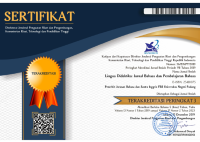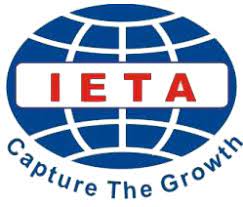Turn Taking Patterns in Merisik Tradition of Malays Batubara Society
 ), Rozanna Mulyani(2), Eddy Setia(3),
), Rozanna Mulyani(2), Eddy Setia(3), (1) Fakultas Ilmu Budaya, Universitas Sumatera Utara
(2) Fakultas Ilmu Budaya, Universitas Sumatera Utara
(3) Fakultas Ilmu Budaya, Universitas Sumatera Utara
 Corresponding Author
Corresponding Author
Copyright (c) 2021 Lingua Didaktika: Jurnal Bahasa dan Pembelajaran Bahasa
DOI : https://doi.org/10.24036/ld.v15i2.109199
Full Text:
 Language : id
Language : id
Abstract
Merisik is a traditional ceremony that is in the Malay tribe. This event brought together two families, man and woman side. The purpose of this event is to know each other between the bride and groom. This event led by Bentara Sabda who had been appointed by each family. Thus, there are only two people who will interact in this event to represent each family. In this study,1) turn taking pattern,2) the relationship of utterances of the closest pair,3) the signs of the closest pair of utterances, and 4) how to obtain a turn of speech in Merisik, will be discussed. The method in this study is a descriptive qualitative. The results obtained are 1) having a perfect pattern that is in accordance with the ABAB formula, 2) there are two speech relationships and the closest pair of utterances, namely delivery and questions, 3) this event only obeys the two signs of the closest speech pair, namely utterances from different speakers and consists of two parts of speech, 4) there are two ways to get a turn of speech, namely by obtaining and seizing.
Keywords
References
Affandi, A. (2013). Pola Alih Tutur Anak Remaja di Desa Sabang Kecamatan Dampelas. Bahasa dan Sastra, Vol. 2, No. 1, 1-15.
Akmal. (2015). Melayu Riau (Pantun, Syair, Gurindam). Risalah Vol. 26, No. 4, 159-165.
Arikunto, S. (2010). Prosedur Penelitian Suatu Pendekatan Praktik. Jakarta: Rineka Cipta.
Cook, G. (1989). Discourse. Oxford: Oxford University Press.
Creswel, J. W. (2017). Research Design: Pendekatan Kualitatif, Kuantitatif, dan Campuran (Terjemahan Achmad Fawaid dan Rianayati Kusmini Pancasari dari Research Design, Qualitative, Quantitative, and Mixed Methods Approaches). Yogyakarta: Pustaka Pelajar.
Gunawan, I. (2015). Metode Penelitian Kualitatif Teori dan Praktik. Jakarta: Bumi Aksara.
Maulina, D. E. (2017). Keanekaragaman Pantun di Indonesia. Semantik, 107-121.
Moleong, L. J. (2007). Metode Penelitian Kualitatif. Bandung: Remaja Rosdakarya.
Mulyani, R., & Freddy Sihombing, N. (2020). Tepak Sirih Melayu Deli Serdang. Surabaya: Pustaka Media Guru.
Napitupulu, S. (2013). Marhata Dalam Upacara Adat Perkawinan Batak Toba. Medan: Universitas Sumatera Utara.
Purwoko, H. (2008). Discourse Analysis Kajian Wacana Bagi Semua Orang. Jakarta: PT Indeks.
Rani, A., Arifin, B., & Martutik. (2004). Analisis Wacana Sebuah Kajian Bahasa dalam Pemakaian. Malang: Bayumedia Publishing.
Sinar, T. S. (2011). Kearifan Lokal Berpantun Dalam Perkawinan Adat Melayu Batubara. Medan: USU Press.
Sugiyono. (2010). Metode Kualitatif, Kualitatif dan R & D. Bandung: Alfabeta.
Syafitri, E. (2017). Alih Tutur Pada Film 99 Cahaya di Langit Eropa Sutradara Guntur Soeharjanto dan Implikasinya Terhadap Mata Kuliah Keterampilan Berbicara. Bandar Lampung: Universitas Lampung.
Trahutami, S. I. (2012, Januari 1). Struktur Pola Alih Tutur Pada Percakapan Anak-anak. Humanika, Vol. 15, No. 9, 1-8.
 Article Metrics
Article Metrics
 Abstract Views : 306 times
Abstract Views : 306 times
 PDF Downloaded : 87 times
PDF Downloaded : 87 times
Refbacks
- There are currently no refbacks.
Copyright (c) 2021 Lingua Didaktika: Jurnal Bahasa dan Pembelajaran Bahasa

This work is licensed under a Creative Commons Attribution-NonCommercial 4.0 International License.









